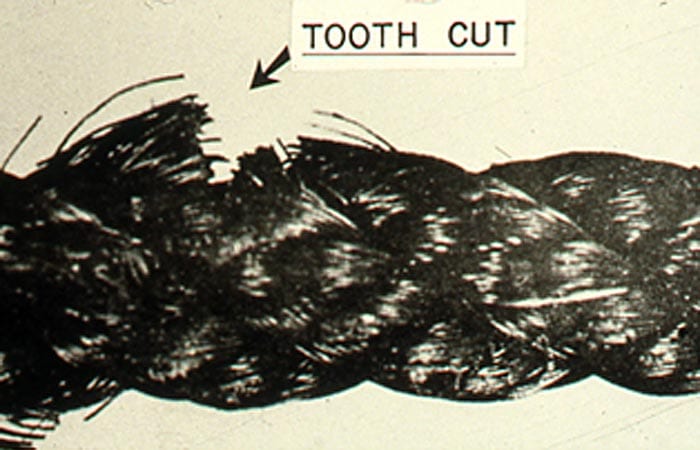
When ‘The Fish Are Biting’ Is Bad News
Researchers found cause of mysterious damage to mooring lines
<!–
–>
Among the odds and ends in Rick Trask’s office is the tip of a swordfish bill, mounted on a piece of wood and displayed on the windowsill. For the manager of the Mooring and Rigging Shop at Woods Hole Oceanographic Institution, it’s a trophy of sorts, though not of the sport-fishing kind. Rather, it’s a reminder of a once-mysterious phenomenon that plagued Buoy Group engineers in the early days of deep-sea mooring deployments.
Trask isn’t sure who mounted the bill, only that it’s been passed among Buoy Group members through the years. The story goes that Buoy Group engineers found the bill while recovering a deep-sea mooring in the late 1960s.
Accustomed to the ocean’s harsh conditions, engineers expected many of their recovered moorings to be damaged: buoys covered in algae, synthetic lines frayed from stress, metal components and instruments rusted by saltwater. But as they hauled this mooring on deck, they saw something unique—the jagged, sandy-colored fragment jammed into the rotor of a current meter, as if the swordfish had attacked the instrument—and lost. The team brought the bill home to Woods Hole and put it on display.
Trask, who first heard the story when he came to WHOI in 1980, inherited the trophy in 1985. “It reminds me that when we put things in the ocean, the unthinkable can sometimes happen,” he said.
An unknown foe
Whenever engineers in the WHOI Buoy Group recovered moorings, they “autopsied” the remnants to try to identify the reasons for failure. Some were obvious: A powerful storm snapped a line, barnacles crusted over an instrument, salt corroded the links in a chain so badly they broke.
But from the very beginning, some moorings came back with “chatter”—slashes and gouges—whose source was not obvious. Some lines were cut all the way through, and oddly, not all of the severed lines looked the same. Some had ragged, ponytail-like ends, which might be expected if they had torn under stress. Others had cleaner ends that looked as if they’d been cut by a knife. Stranger still, some lines showed both kinds of damage—some strands looked cut, while others looked shredded. Buoy Group engineers wondered: What—or who—was damaging the moorings?
Vandalism was possible, but not likely. Vandals were known to mess with moorings; but they usually shot them, cut them adrift, banged into them, or stole them. Who would bother to pull up several hundred meters of rigging just to damage it and then put it back?
Abrasion didn’t seem likely, either. Moorings came back with damage at many places along the upper 1,000 meters of line. What could the line be rubbing against at so many different depths?
As more and more moorings came back with unexplained damage, some members of the Buoy Group began to focus on an unexpected threat: fish. They had no proof, but they suspected fish were attacking the rigging and other mooring components, not just occasionally, but on a regular basis.
The suggestion that fish posed a frequent threat to moorings didn’t go over well with everyone in oceanography. Some found it hard to believe that fish teeth and jaws could inflict so much damage. And if “fish bite” was a major problem, what did that mean for the future of mooring operations?
Fishy forensics
As early as 1963, the Buoy Group began documenting instances of suspected fish bite on recovered moorings. As they hauled each piece of a mooring on deck—flotation, instruments, synthetic rope, and various metal components—they quickly noted areas of possible fish bite and at what depth the damage had occurred. They documented frayed rope ends, instruments with long gashes, and lines with different kinds of nicks and cuts. When they got back to WHOI, they went over the equipment more carefully and found hundreds more small lacerations that they thought could have been inflicted by fish.
The engineers also set up a lab where, over the next several years, they conducted their own version of forensic science on both new and recovered rigging. The team simulated the myriad ways rigging lines could break. They subjected wire ropes and four kinds of synthetic lines to different kinds of injury, rubbing them until they frayed, pulling them until they broke, and slicing them with knives and box cutters.
The investigators also ripped ropes when they were dry and when they were soaking wet. They used sophisticated machines such as tensiometers to pull their samples apart, and invented a “Bitemeter” to test how much force was required to puncture lines of different materials with a conical, fish tooth-like bit of steel. They even tried cutting the lines with shark teeth that were still attached to the jaws.
“As cutting tools, fish teeth, notably those of sharks, compare favorably well with the sharpest man made blades such as the blades of razors and utility knives,” wrote WHOI engineers Henri Berteaux and Bryce Prindle in a summary account published in 1987.
The team learned that ropes torn under stress have ragged ends, while ropes cut with sharp objects have cleaner edges. The clean tears mimicked the suspected fish bites that had been found on recovered gear. The group reasoned that recovered lines that showed both clean and ragged damage had probably suffered a fish bite through some strands, creating the clean cuts. The remaining strands then had to bear the full weight of the mooring, and they eventually tore, creating the ragged ends.
Hard proof
In 1964, while continuing their lab tests, the Buoy Group set two moorings near Bermuda in hopes of obtaining hard proof that fish attacks were no fluke.
The first test mooring was deployed that spring in 2,000 meters of water and rigged with synthetic rope. The group commonly used synthetic rope for moorings because it didn’t corrode in salt water as wire rope did, and its elasticity enabled it to absorb the up-and-down motion of waves. The engineers sheathed the upper 1,200 meters of the line with a coating of polyvinyl chloride (PVC) in an attempt to protect it from fish attacks. They left the bottom portion of the rope—which would be deeper than most fish roam—exposed. The team planned to inspect the mooring for evidence of fish bite after one week, then re-set it for a longer-term test.
They weren’t sure such a brief exposure would be long enough to see whether the fish were biting. They needn’t have worried. After just a week in the water, the mooring looked like a prop in a slasher movie. It had suffered more than 40 clusters of cuts and gouges. In fact, the rigging was so ripped up the engineers feared it would not withstand further stress. They scrapped their plans for a longer deployment and took a closer look at the tantalizing clues from the injured mooring.
By comparing the depth, size, and spacing of cuts with the strength, size, and spacing of the teeth and jaws of potential biters, the group ruled out sea turtles (beaks not hard enough) and squid (beaks not the right size and shape). Sharks emerged as likely villains in warm-water deployments but probably were not responsible for damage to lines in the colder depths.
On the failed Bermuda mooring, 29 of the damaged areas had cuts in pairs, as if made by teeth on the left and right sides of a fish’s jaw. But the cuts were only on one side of the line, as if the fish that made them had teeth in only the upper or lower jaw.
The group began casting around for culprits—fish that roamed deep enough, had teeth in only the upper or lower jaw, and were large enough to have made the marks found on the moorings. The most likely was an eel-like, deep-dwelling fish called Sudis hyalina, which has strong, finely serrated teeth in its lower jaw and tiny nubbins of teeth in its upper jaw.
Later that fall, the group set the second test mooring near the site of the first. Buoy Group engineers had been experimenting with other types of lines, trying to find a material that would be more durable than the synthetic ropes they had been using. The new mooring used galvanized steel wire covered with a polyethylene jacket to protect it from corrosion by saltwater. Engineers suspended the line from a float about 50 meters below the surface. They also attached pine and asbestos panels at various points along the rigging to collect creatures known to cause biofouling.
When the mooring was pulled up after about 40 days in the water, it, too, had sustained severe damage—more than 1,000 slashes, tears, and tooth impressions. The stretch that had been 400 to 800 meters deep had been hit especially hard. The wire rope was intact, but its polyethylene jacket was shredded. As with the first mooring, many of the cuts were made in pairs but on just one side of the line.
Better yet, one of the cuts and one of the pine panels had tooth fragments embedded in them—proof positive that fish were responsible. Examining the tooth fragments under a microscope, the group found tiny serrations, confirming that Sudis was the culprit. However, the tooth fragments in the panel were a different shape and had smooth edges. They were identified as belonging to the lancet fish, Alepisaurus ferox.
At last, the oceanographic community was convinced: Fish bite was real. As Berteaux and Prindle would later write, “the suspicion that the lines were being bitten became fact.”
Fish-driven design
By then it was clear that synthetic ropes weren’t strong enough to withstand repeated fish attacks, even when jacketed with plastic.
The group had been using synthetic line because wire rope had a disconcerting tendency to kink and coil back on itself when slack, creating tangled “wuzzles” and sometimes snapping, like a paper clip that is bent too far. However, wire’s ability to withstand fish attacks outweighed that shortcoming. The group improved and standardized its methods of handling wire rope to minimize wuzzle formation and began using wire rope sheathed in polyethylene down to 1,500 meters on all moorings. Later, they would extend the sheathed wire rope down to 2,000 meters for even more protection. Jacketed wire was subject to corrosion where fish bites penetrated the sheath, but was still an improvement over the more vulnerable synthetic ropes.
By 1975, the group had enough data to publish a report for the National Oceanographic and Atmospheric Administration (NOAA). Written by Prindle and Bob Walden, who headed the mooring and buoy engineering section of the Buoy Group, the report summarized much of what they all had learned about fish bite and how to defend against it. Despite the gains made in conquering fish bite, gaps remained.
In the late 1980s, their curiosity piqued by the lingering questions, Prindle and Henri Berteaux reopened the fishbite investigation. Reaching back into the volumes of data the Buoy Group had gathered over the years, they conducted a comprehensive study of 550 moorings set from 1967 to 1985. They aimed to produce an illustrated field and laboratory guide to fishbite damage, expanding Prindle and Walden’s manual to “bring the subject up to date so that the state-of-the-art would be generally available.”
They summarized the forensic work the WHOI group had done over the years, to help ocean engineers evaluate mooring damage and determine what had caused it. They provided detailed descriptions of their methods for testing potential rigging materials and photographs of lines damaged in various ways. Berteaux and Prindle concluded that the appearance of cut or torn lines could be suggestive of fish bite, but the surest evidence was tooth impressions in a wire rope’s plastic jacket, or actual tooth fragments. “Fishbite identification remains a patient art,” they wrote.
Thinking like a fish
Berteaux and Prindle also scoured the records for more clues about who was biting and why. They plotted the location of each incidence of fish bite by latitude and longitude, depth, and length of time in the water.
The pair turned next to geography. Did fish bite happen everywhere, or was it concentrated in certain regions of the ocean? Their analysis was limited by the distribution of WHOI moorings, few of which had been set in the Pacific and Indian Oceans or in high latitudes of either hemisphere. However, for the Atlantic Ocean, the pattern was clear: More than 99 percent of fishbite cases occurred in the area from 40 degrees North of the Equator to 40 degrees South, with the frequency rising closer to the equator. Berteaux and Prindle termed this area the “Fishbite Zone,” and concluded that about 28 percent of moorings set in that zone would suffer fishbite damage.
Next, the duo focused on the point in a mooring’s life when fish seemed to bite the most. Records showed that the longer moorings were in the water, the more likely they were to be bitten. Attacks late in a deployment made sense, because as a mooring sits in the water, tasty tidbits became attached to the line—algae and barnacles on the upper reaches and a variety of gelatinous planktonic creatures on the lower. Biologists reported that about two-thirds of the animals that live in the ocean’s depths bioluminesce, so it was possible that many of the creatures stuck to the line were emitting light, making themselves very visible to predatory fish swimming nearby.
But moorings also seemed to be attacked as soon as they were dropped in the water. The investigators weren’t completely surprised by this; after all, the group had experienced fish bite with the one-week test deployment back in 1964. The pair wondered, if fish attack mooring lines in an effort to nab the animals stuck there, why do they also bite moorings fresh off the ship?
“At first thought, a small black inert plastic line may seem to be a sorry bait,” wrote Berteaux and Prindle, “but consider its history as part of a moored array.” They concluded that a confluence of events attracts fish to the ship’s trail, then entices them to bite the newly deployed mooring.
Fish are attracted by new movement in the water, especially when that movement is a bright, flashy object, they wrote. The ship, with its foamy wake, rumbling engines, trail of trash, and bright anti-fouling paint, entices fish to follow along. Once the ship is on station, all of those signals—auditory, chemical, visual—concentrate under the hull. Suddenly, a flashy object is tossed in—it must be food! Fish zoom in for a munch.
Berteaux and Prindle suggested that painting buoys in dull, non-reflective colors could reduce the visual appeal of a new mooring, but there’s no way to prevent plankton from accumulating on the lower parts of a mooring line and fish from biting at them. The only defense was the one the Buoy Group resorted to years before—using jacketed wire rope rather than synthetic rope in regions where fish bite was likely.
Lessons become legend
NOAA published Berteaux and Prindle’s findings in 1987. The Deep Sea Moorings Fishbite Handbook is still the go-to reference on fish attacks for oceanographers and mooring engineers. Yet despite answering the major questions surrounding fish bite—who, what, when, where, and why—some questions remained.
For instance, problems with fish bite were wildly variable. One station near Bermuda experienced no fish bites one year, then 95 cases the next. Why the difference? Was it the weather? The water temperature? Currents? The pair could only scratch their heads. Some problems would have to wait to be solved.
But fish attacks on moorings are part of the oceanographic culture now. For decades, new generations of mooring engineers have been initiated into the fishbite fraternity early in their seagoing careers. Trask first witnessed fish damage while on a research cruise in the late 1980s. He recalled that as Buoy Group members hauled a deep-sea mooring back onto the ship, they noticed huge slashes on a vector averaging current meter (VACM). The damaged instrument had chatter on either side, as if something had tried to chomp right through its steel casing.
“These old VACMs are large—they stand as tall as a man and are about 8 inches in diameter,” said Trask. “The hypothesis was that a fish came around and tried to wrap its mouth around the VACM then realized it probably wasn’t a good choice.”
“That was pretty amazing—those are big jaws,” he added.
Stories about fish attacks have become part of the job, too, the kind of tale told to impress rookie mooring engineers: The rotor on a current meter jammed after a fish swam into it; a crucial instrument and its year’s worth of data lost; a bit of a swordfish beak left behind on a mooring.
“So much gets passed down,” said Trask. “You’re at sea and people point it out; you see bits of tooth and the chatter. It’s kind of lore now.”
Slideshow
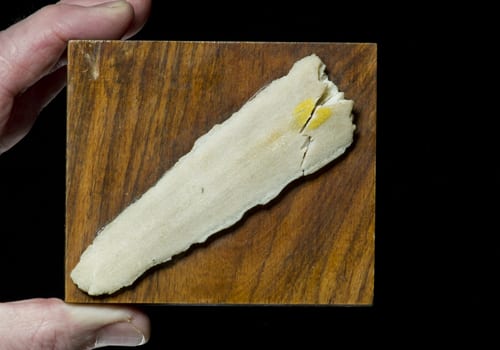
Slideshow
 The tip of a swordfish bill that was found embedded in a deep-sea mooring. The memento has come to represent the challenges WHOI engineers and researchers face each time they deploy a mooring. “It reminds me that when we put things in the ocean, the unthinkable can sometimes happen,” said Rick Trask, manager of WHOI’s Mooring and Rigging Shop.
The tip of a swordfish bill that was found embedded in a deep-sea mooring. The memento has come to represent the challenges WHOI engineers and researchers face each time they deploy a mooring. “It reminds me that when we put things in the ocean, the unthinkable can sometimes happen,” said Rick Trask, manager of WHOI’s Mooring and Rigging Shop.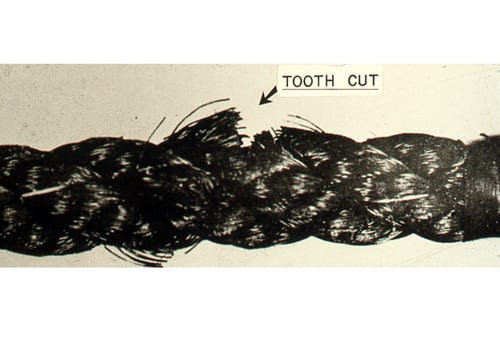 Mooring lines made of wire rope covered with plastic also sustained damage that looked like fish attacks. On this segment of line, the plastic jacket suffered a puncture (round hole at right) and several cuts (diagonal marks left of the hole). Suspecting that bumps in the line near the cuts might be bits of teeth, WHOI engineers x-rayed the line (see next photo).
Mooring lines made of wire rope covered with plastic also sustained damage that looked like fish attacks. On this segment of line, the plastic jacket suffered a puncture (round hole at right) and several cuts (diagonal marks left of the hole). Suspecting that bumps in the line near the cuts might be bits of teeth, WHOI engineers x-rayed the line (see next photo).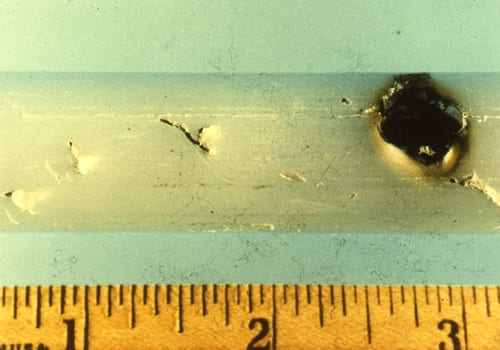 Mooring lines made of wire rope covered with plastic also sustained damage that looked like fish attacks. On this segment of line, the plastic jacket suffered a puncture (round hole at right) and several cuts (diagonal marks left of the hole). Suspecting that bumps in the line near the cuts might be bits of teeth, WHOI engineers x-rayed the line (see next photo).
Mooring lines made of wire rope covered with plastic also sustained damage that looked like fish attacks. On this segment of line, the plastic jacket suffered a puncture (round hole at right) and several cuts (diagonal marks left of the hole). Suspecting that bumps in the line near the cuts might be bits of teeth, WHOI engineers x-rayed the line (see next photo).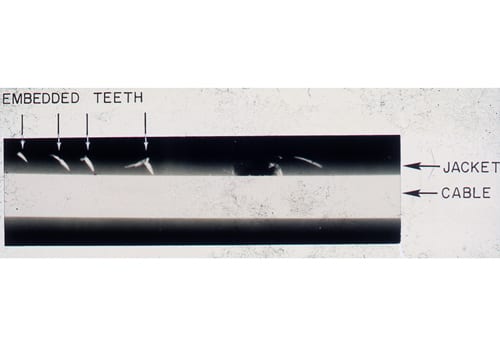 An X-ray of the jacketed wire rope seen in the previous photo shows fragments of fish teeth embedded in the plastic jacket—hard proof that fish bite mooring lines.
An X-ray of the jacketed wire rope seen in the previous photo shows fragments of fish teeth embedded in the plastic jacket—hard proof that fish bite mooring lines.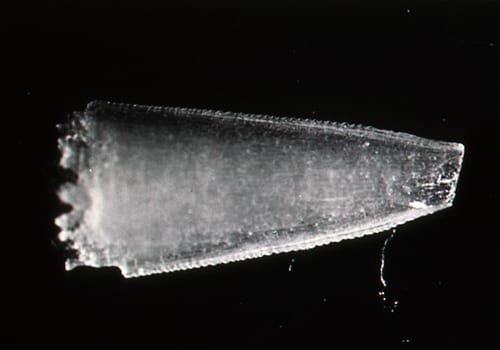 The tip of a fish tooth that broke off inside a mooring line. The tooth, from the lower jaw of the deep-sea species Sudis hyalina, has fine serrations that enable it to cut cleanly through ropes made of synthetic fibers. Sudis grows to more than a meter in length.
The tip of a fish tooth that broke off inside a mooring line. The tooth, from the lower jaw of the deep-sea species Sudis hyalina, has fine serrations that enable it to cut cleanly through ropes made of synthetic fibers. Sudis grows to more than a meter in length.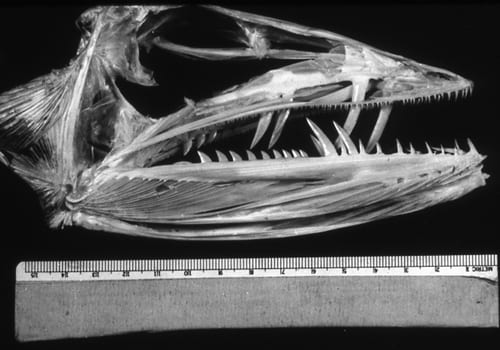 A skull of the deep-sea fish Alepisaurus ferox, whose long, sharp teeth can inflict major damage on mooring lines and instruments.
A skull of the deep-sea fish Alepisaurus ferox, whose long, sharp teeth can inflict major damage on mooring lines and instruments.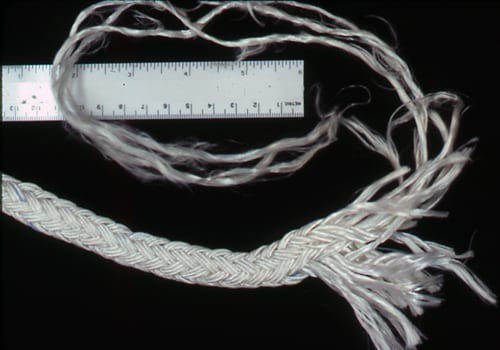 Occasionally, a synthetic mooring line was recovered with two very different kinds of damage: Some fibers had clean, blunt ends while others had frayed, ponytail-like ends. WHOI engineers concluded that the clean cuts were inflicted by biting fish and the frayed ends resulted when the remaining intact fibers were unable to bear the full weight of the mooring, and pulled apart under tension.
Occasionally, a synthetic mooring line was recovered with two very different kinds of damage: Some fibers had clean, blunt ends while others had frayed, ponytail-like ends. WHOI engineers concluded that the clean cuts were inflicted by biting fish and the frayed ends resulted when the remaining intact fibers were unable to bear the full weight of the mooring, and pulled apart under tension.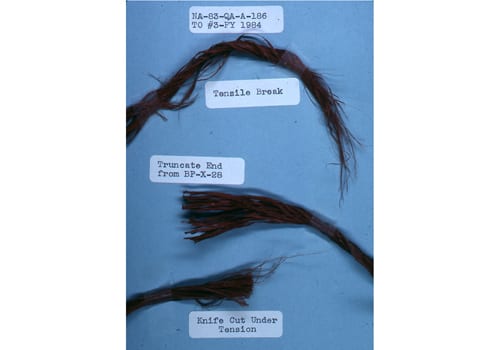 WHOI engineers compared mooring lines they thought had been cut by fish (center) with ropes damaged in the rigging shop by knife blade (bottom) or by being pulled apart under tension (top).
WHOI engineers compared mooring lines they thought had been cut by fish (center) with ropes damaged in the rigging shop by knife blade (bottom) or by being pulled apart under tension (top).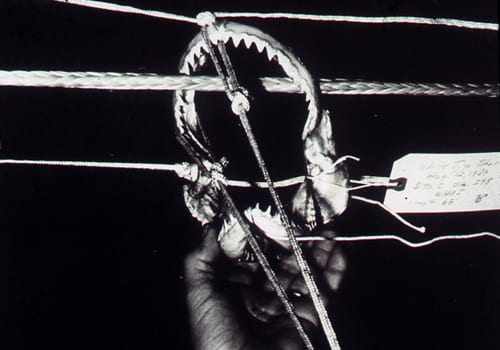 Buoy Group engineers subjected wire rope, four kinds of synthetic rope, and several kinds of sheathing materials to 14 kinds of damage in hopes of identifying how rigging breaks, and what kinds of rigging hold up best against fish attack. Here, an engineer simulates how a shark could cut a synthetic rope pulled taut by the weight of attached instruments.
Buoy Group engineers subjected wire rope, four kinds of synthetic rope, and several kinds of sheathing materials to 14 kinds of damage in hopes of identifying how rigging breaks, and what kinds of rigging hold up best against fish attack. Here, an engineer simulates how a shark could cut a synthetic rope pulled taut by the weight of attached instruments.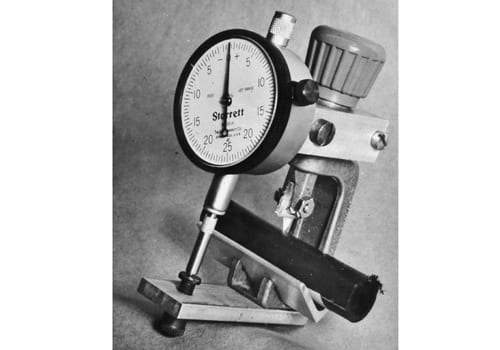 WHOI engineers developed the “Bitemeter” to measure the force needed to drive a sharp object, such as a shark’s tooth, into rigging components and to test the ability of those components to resist punctures by fish teeth. “It took a long time before we developed moorings that were resistant to sharks,” recalled former WHOI scientist Ferris Webster.
WHOI engineers developed the “Bitemeter” to measure the force needed to drive a sharp object, such as a shark’s tooth, into rigging components and to test the ability of those components to resist punctures by fish teeth. “It took a long time before we developed moorings that were resistant to sharks,” recalled former WHOI scientist Ferris Webster.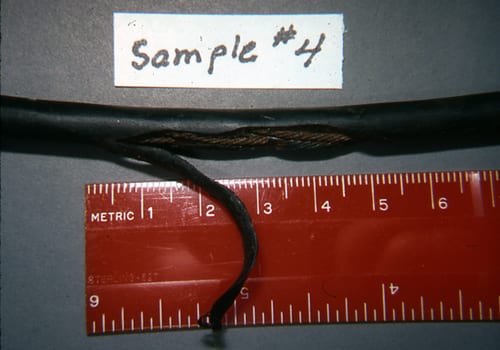 The introduction of jacketed wire rope in the mid-1960s solved some major problems for the Buoy Group—it was harder to cut and could withstand the elements better than synthetic rope. But wire rope was still vulnerable to attack: If a fish tooth punctured its plastic jacket, corrosive sea water would cause the wire rope within to rust, putting the mooring at risk.
The introduction of jacketed wire rope in the mid-1960s solved some major problems for the Buoy Group—it was harder to cut and could withstand the elements better than synthetic rope. But wire rope was still vulnerable to attack: If a fish tooth punctured its plastic jacket, corrosive sea water would cause the wire rope within to rust, putting the mooring at risk.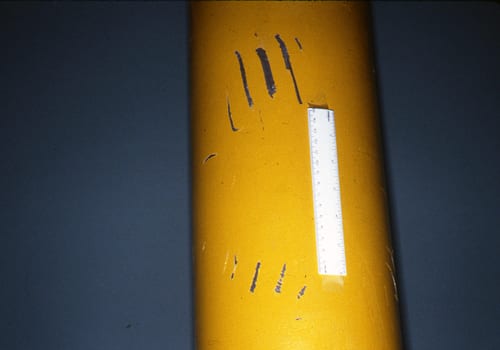 Fish attack instruments as well as rigging. This Vector Averaging Current Meter was attacked by a fish large enough to get its jaws around the 8-inch diameter casing.
Fish attack instruments as well as rigging. This Vector Averaging Current Meter was attacked by a fish large enough to get its jaws around the 8-inch diameter casing.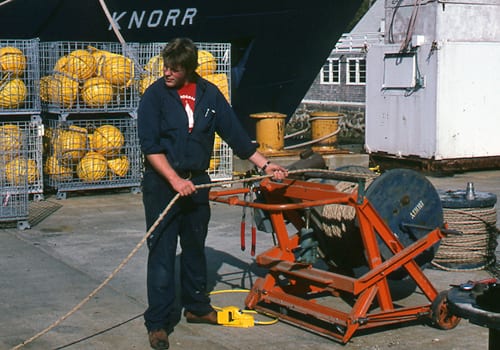 Running a mooring line through human hands as it’s being reeled back aboard ship helps locate cuts, holes, and gouges caused by fish.
Running a mooring line through human hands as it’s being reeled back aboard ship helps locate cuts, holes, and gouges caused by fish. Engineer Henri Berteaux of WHOI and MIT co-wrote the Fishbite Handbook (with Bryce Prindle) as well as leading texts on buoy and mooring design.
Engineer Henri Berteaux of WHOI and MIT co-wrote the Fishbite Handbook (with Bryce Prindle) as well as leading texts on buoy and mooring design.
Featured Researchers
See Also
- Building Them Tough and Bringing Them Back Story about WHOI's Buoy Group from Oceanus magazine
- Outposts in the Ocean History and Background of Moorings and Buoys
- Who was Henri Berteaux?
- Mooring and Rigging Services at WHOI
